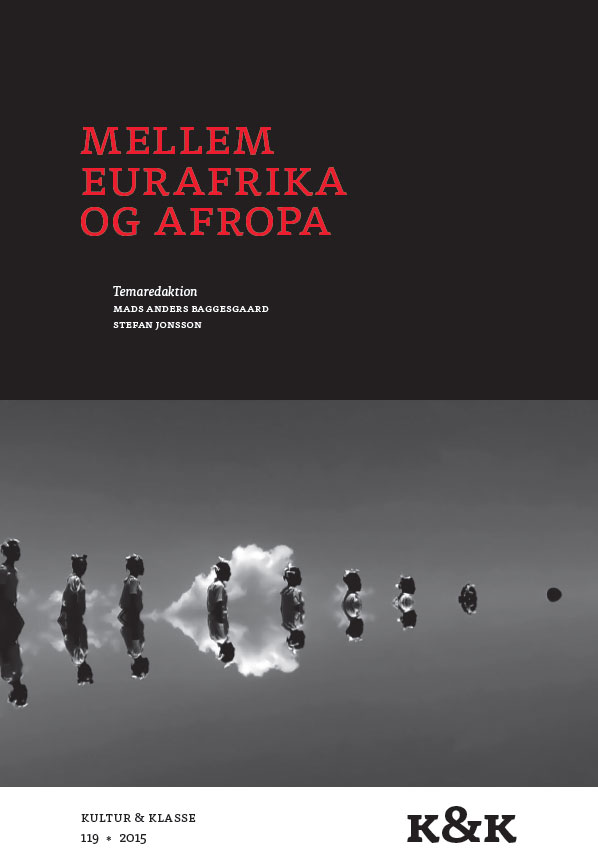Spirituelle revolutioner - Afropæiske kropspolitikker og kunstens ’sekularisering’
DOI:
https://doi.org/10.7146/kok.v43i119.22250Nøgleord:
decolonial, slavery, Haiti, decolonial aesthetics, pan-African, maroonResumé
A Vodoun ceremony heralded the beginning of the end of Europe’s savage capitalist enterprise in the Caribbean and elsewhere. According to Laurent Dubois we are all descendants of the Haitian Revolution and therefore accountable to its ancestry. In my presentation I will discuss how the liberation Pan-Africanist legacies of the maroon leaders that created the first Black Republic is present in some Afropean Decolonial Aesthetics/Aesthesis practitioners, such as Teresa María Díaz Nerio, Jeannette Ehlers, Quinsy Gario and Patricia Kaersenhout, as well as in other Caribbean (Diaspora) artists. Apart from the paradigmatic work of Renée Cox honouring the legacy of the Jamaican heroine Queen Nanny of the Maroons, who was their armed and spiritual leader, there is as well the radical legacy of Ana Mendieta who combined in her work some of the basic premises of maroon life, namely a permanent dialogue with nature and its spirits. Nicolás Dumit Estévez and Charo Oquet, for example, resonate with the spiritual legacies of marronage, consistently contributing to dismantle one of the most successful fallacies of modernity: the so-called ‘secularity’ of the arts. Furthermore, Miami-based Adler Guerrier revisits Charles Mingus’ Haitian Fight Song in a film where his interpretation of the flâneur defies the painful erasure by colonial archives on the African continent and elsewhere on Black radical legacies. This particular type of awareness of a urban landscape as a space where the mere presence of a Black body represents both a transgression and an affirmation of being is reminiscent of the armed struggle spirit of those runaway warriors. In this sense, these artists are expanding the stamina of Decolonial Aesthetics/Aesthesis by focusing their attention on the forms of sensing and inhabiting the world that the modern/colonial order has suppressed.Referencer
Alegría Pons, José Francisco og Soraya Aracena). Gagá y Vudú en la República Dominicana. Santo Domingo: Ediciones El Changó Prieto, 1993.
Copeland, Huey. “Sinous Coordination: On the Photography of Adler Guerrier.” Adler Guerrier: Formulating a Plot. Miami: Pérez Art Museum, 2014.
Benítez Rojo, Antonio. The Repeating Island. Durham: Duke University Pres, 1996.
Boyce Davies, Carole. ”12 Years a Slave fails to represent black resistance to Enslavement”. The Guardian 10. jan, 2014.
Brodber, Edna. The Continent of Black Consciousness: On the History of the African Diaspora from Slavery to the Present Day. London: New Beacon Books, 2003.
Britton, Celia. Edouard Glissant and Postcolonial Theory: Strategies of Language and Resistance. Charlottesville: University Press of Virginia, 1999.
Cosentino, Donald J. Vodou Things. The Art of Pierrot Barra and Marie Cassaise. Jackson: University Press of Mississippi, 1998.
Debord, Guy. “Introduction to a Critique of Urban Geography.” Les Lèvres Nues 6 (1955). [forlag, sidetal?]
Díaz Nerio, Teresa María. Ni ’mamita’ ni ’mulatita’. Performancetekst. Manuskript, 2013.
Dubois, Laurent. Avengers of the New World: A History of the Haitian Revolution. Boston: Belknap Press, 2005.
El-Tayeb, Fatima. “The Forgotten Empire: Race, Colonialism, and German National Identity”. Who Knows Tomorrow. Red. Udo Kittelmann, Chika Okeke-Agulu, Britta Schmitz. Köln: Walther König, 2010.
Estévez, Nicolás Dumit. Forelæsning givet af kunstneren ved arrangementet “Gender and the Caribbean Body”, 28. april 2014, tilrettelagt af CUNY Diversity Projects Development Fund and Barnard College. Manuskript.
Gario, Quinsy. Nets Have Many Holes. Digtperformance. Amersfoort: Framer Framed, 2012.
Hall, Stuart. Cultural Identity and Diaspora. Framework 36 (1989): 222-37.
Jung, C.G. Paracélsica. Barcelona: Editorial Kairós, 1995.
Lao-Montes, Agustín. “Hilos Descoloniales. Trans-localizando los espacios de la Diáspora Africana.” Tabula Rasa 7 (2007): 47-79.
Lockward, Alanna. “Saint Domingue Kins in the Continent of Black Consciousness.” Trenzando una Historia en Curso: Arte Contemporáneo Dominicano en el Contexto del Caribe. Santiago De Los Treinta Caballeros: Centro León & JP Morgan, 2014.
Lockward, Alanna. ”Black Europe Body Politics: Towards an Afropean Decolonial Aesthetics.” Social Text, Periscope, 15. juli 2013. sidetal?
Lorde, Audre. “Age, Race, Class and Sex: Women Redefining Difference.” Sister Outsider. Los Angeles: Freedom, 1984: 114-123.
Malik, Amna. “Conceptualising ‘Black’ British Art Through the Lens of Exile.” Exiles, Diasporas & Strangers. Red. Kobena Mercer. London: Iniva, 2008.
McFarlane, Anthony. “Cimarrones and Palenques: runaways and resistance in colonial Colombia.” Out of the house of bondage: runaways, resistance and marronage in Africa and the New World. Red. Gad Heuman. London: Cass, 1986: 131-151.
Mercer, Kobena. “Cosmopolitan Contact Zones.” Afro Modern: Journeys through the Black Atlantic. Liverpool: Tate, 2010: 48-57.
Mignolo, Walter. “Decolonial Aisthesis and Other Options Related to Aesthetics.” Alanna Lockward og Walter D. Mignolo (red.), BE.BOP 2012: Black Europe Body Politics. Berlin: Ballhaus Naunynstraße, 2012: 5–8.
Mignolo, Walter & Tlostanova, Madina. “Global Coloniality and the Decolonial Option.” Kult 6 (200): 134-136.
Montano, Linda. Performance Artists Talking in the Eighties. Berkley: University of California Press, 2004.
Oquet, Charo. Gagá. Honor Thesis Prof. Manuel Torres, Florida International University, 1999.
Patterson, Tiffany Ruby og Robin D. G. Kelley. “Unfinished Migrations: Reflections on the African Diaspora and the Making of the Modern World.” African Studies Review, 43.1 (2000): 11-46.
Peguero Guzmán, Luis Alejandro. ”¿Vudú Dominicano o Vudú en Santo Domingo?” Boletín Americanista 49 (1999): 211-31.
Rice, Shelley. Inverted Odysseys: Claude Cahun, Maya Deren, Cindy Sherman. New York: MIT University Press, 1999.
Roach, Joseph. Cities of the Dead. Circum-Atlantic Performance. New York: Columbia University Press, 1996.
Santiago-Valles, Kelvin A. “’Race,’ Labor, ‘Women’s Proper Place,’ and the Birth of Nations: Notes on Historicizing the Coloniality of Power.” The New Centennial Review 3.3 (2003): 47-69.
Tate, Gregg (red.) Everything But the Burden: What White People Are Taking from Black Culture. New York: Broadway Books, 2003.
Tejeda Ortiz, Dagoberto. El Vudú en Dominicana y en Haití. Santo Domingo: Edición Indefolk, 2014.
Trouillot, Michel-Rolph. Silencing the Past: Power and the Production of History. Boston: Beacon, 1995.
Zorach, Rebecca. “Place Becomes Sweet and Great. A Conversation with Adler Guerrier.” Adler Guerrier: Formulating a Plot. Miami: Pérez Art Museum, 2014: 77-96.
Downloads
Publiceret
Citation/Eksport
Nummer
Sektion
Licens
Tidsskriftet følger dansk ophavsret.





